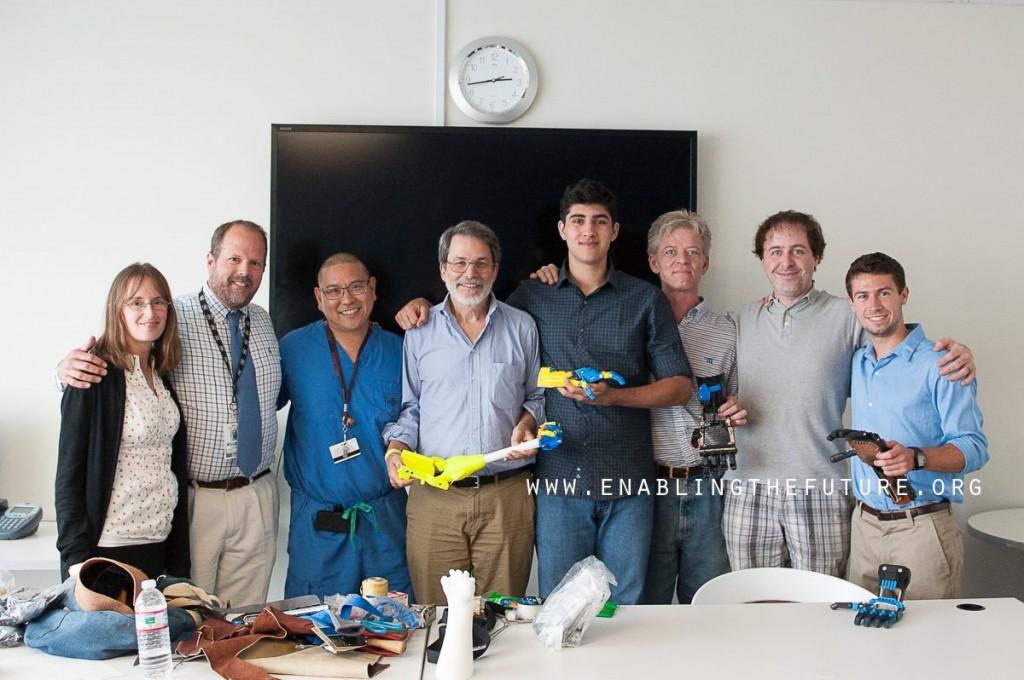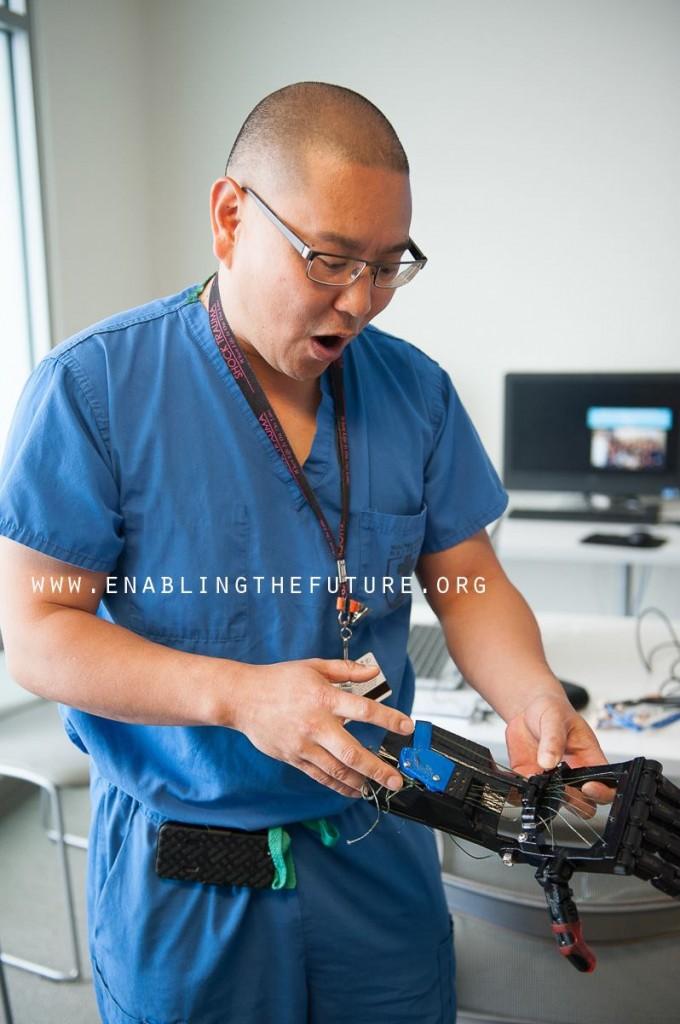“Shut the Front Door,” Exclaims Impressed Trauma Surgeon After Seeing 3D Printed $50 Prosthetic Hand from e-NABLE
Over the past year, I have personally covered about a dozen or so articles all surrounding the wonderful and amazing developments of e-NABLE. For those that haven’t read my other articles, e-NABLE is a group of volunteers who work together to provide affordable 3D printed prosthetic hands and arms for people in need. Most of their beneficiaries are children, who end up facing difficulties with traditional prosthetics, due to the fact that they are constantly outgrowing them. When a prosthetic hand costs upwards of $50,000, it just isn’t feasible for children to be fitted with them. e-NABLE, on the other hand, utilizes 3D printing in order to create custom robotic looking prosthetics, that cost approximately $50 each to develop.
There is a lot of discussion now-a-days about the use of affordable health care options. Many people believe that big medicine, hospitals, and doctors forego the use of natural remedies, as well as medicine and medical devices that are not ‘patentable’, due to the fact that there isn’t money to be made with them. This is a debate which I personally won’t get involved in, and I honestly don’t have an opinion on. With all of this said, however, at least one doctor is proving that this just isn’t always the case.
Dr. Albert Chi, a trauma surgeon and leader in research surrounding upper extremity amputations and spinal cord injuries, at the John Hopkins Medical Center in Baltimore, Maryland, had contacted members of e-NABLE last month, in hopes of meeting with some of them and learning about the creation of 3D printed prosthetic hands. Chi is well known in the field, and has been working on some incredibly advanced technologies which allow for amputees to use their brain in order to control bionic arms. With these arms, all a patient needs to do is think about moving his/her arm and/or hand in a certain way, and the computerized device takes action. (see video below of Dr. Chi and a patient):
This technology is without a doubt the future. It is obviously well more advanced than anything that has yet to be 3D printed. However, when members of e-NABLE went to meet with Dr. Chi, his reaction explained a lot. Four of the core e-NABLE members went to Baltimore to meet with Chi. Those members were e-NABLE founder, Jon Schull, as well as the co-creator of the first ever 3D printed hand design, Ivan Owen, Peter Brinkley, and Jen Owen.
When they showed Dr. Chi their different variations of 3D printed prosthetic hands, his reaction was priceless.
“Watching a man who spends his days hooking up electrodes to his patients and working with some of the most advanced technology in upper limb prosthetics – get excited and laugh out loud when he picked up a $50 e-NABLE 3D printed prosthetic hand and made it move – was incredible,” explained Jen Owen. “While we were standing there in awe of his amazing talent and taking in the advanced robotic options for Dr. Chi’s amputee patients – he was like a kid in a candy store.”
A man who is far more advanced than 99.9% of humanity, when it comes to the creation of prosthetic hands, was in awe over what a $50 3D printed prosthetic hand could do. “I believe he exclaimed ‘SHUT THE FRONT DOOR!’ more than once during our visit,” said Jen Owen.
Chi has a desire to create some of these 3D printed hands for his patients. It should be interesting to see what types of modifications he may recommend to e-NABLE. Surely he has to have some unique ideas that could potentially revolutionize the 3D printing of prosthetic hands. “It was a whirlwind of information, sharing of ideas and coming up with ways to collaborate together for some HUGE and amazing things that will be announced soon,” said Owen.
What these ‘huge’ things are, have not yet been announced, but from my talks with some of the other core e-NABLE members, I’ve learned that they have hopes of developing their own myoelectric 3D printed hand in the future. Could Dr. Chi perhaps be the final piece to this puzzle? Could we one day, in the very near future, be able to print out robotic hands and arms that respond to our thoughts and minor muscle movements? I am willing to bet on it.
What do you think will come about between Dr. Chi and e-NABLE? Do you think that one day soon, anyone without a hand will be able to 3D print a device like that shown in the video of Chi above? Discuss in the 3D printing of prosthetic hands forum thread on 3DPB.com.
Subscribe to Our Email Newsletter
Stay up-to-date on all the latest news from the 3D printing industry and receive information and offers from third party vendors.
You May Also Like
3D Printing Unpeeled: New Arkema Material for HP, Saddle and Macro MEMS
A new Arkema material for MJF is said to reduce costs per part by up to 25% and have an 85% reusability ratio. HP 3D HR PA 12 S has been...
3D Printing News Briefs, January 20, 2024: FDM, LPBF, Underwater 3D Printer, Racing, & More
We’re starting off with a process certification in today’s 3D Printing News Briefs, and then moving on to research about solute trapping, laser powder bed fusion, and then moving on...
3D Printing Webinar and Event Roundup: December 3, 2023
We’ve got plenty of events and webinars coming up for you this week! Quickparts is having a Manufacturing Roadshow, America Makes is holding a Member Town Hall, Stratafest makes two...
Formnext 2023 Day Three: Slam Dunk
I’m high—high on trade show. I’ve met numerous new faces and reconnected with old friends, creating an absolutely wonderful atmosphere. The excitement is palpable over several emerging developments. The high...



































